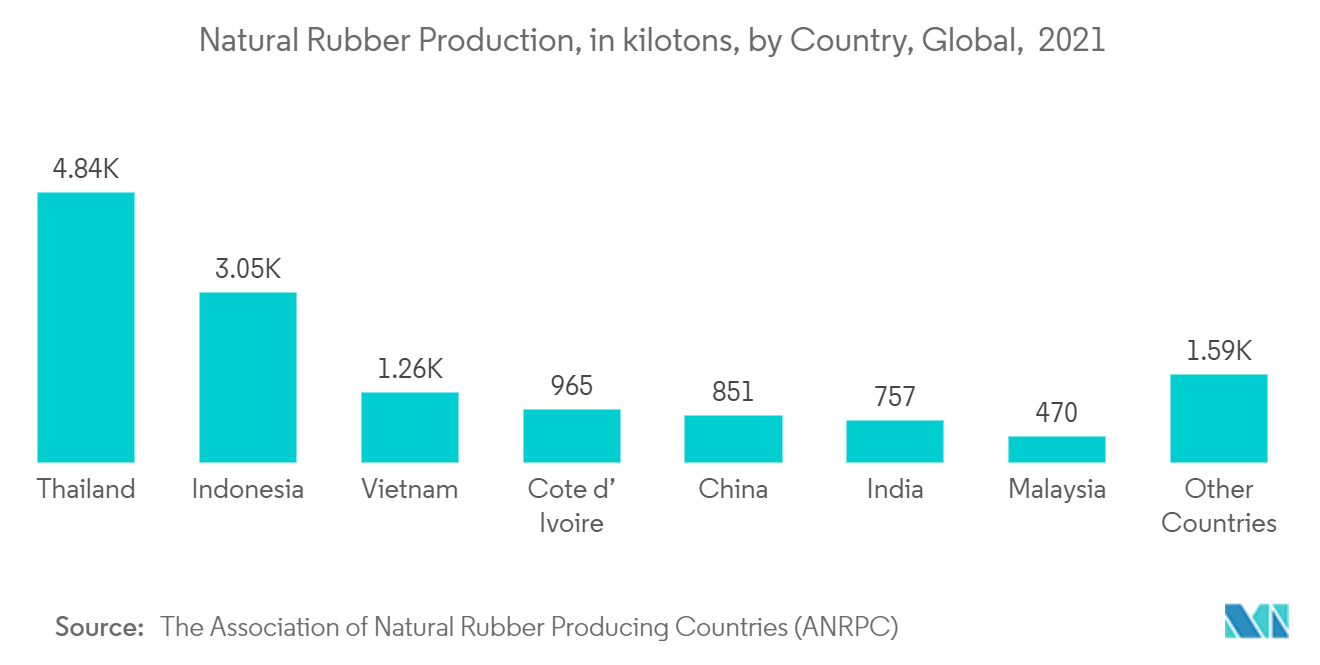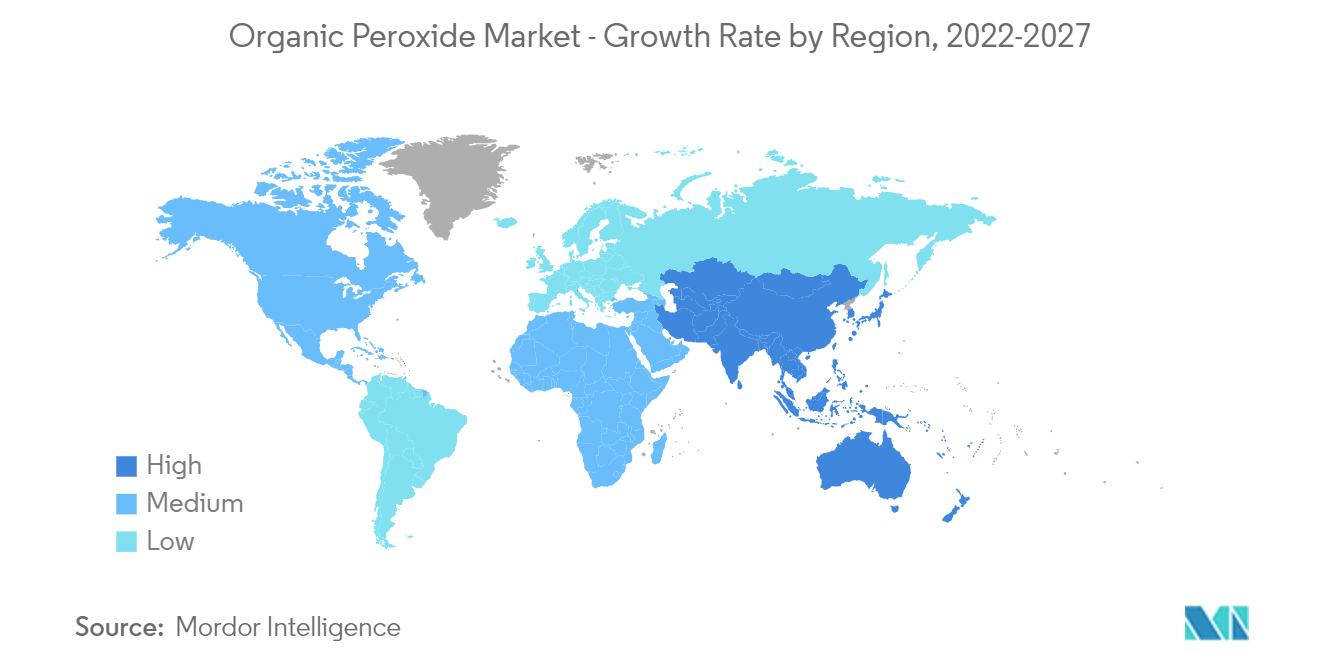Market Trends of Organic Peroxide Industry
This section covers the major market trends shaping the Organic Peroxide Market according to our research experts:
Polymers and Rubbers to Dominate the Market
- Organic peroxides are used as an initiator in plastics manufacturing, curing agents, elastomers, thermoplastics cross-linking agents, and synthesis and modification of polymers.
- Organic peroxides are used as cross-linking agents for saturated and unsaturated rubbers. On the polymer chain, the peroxide decomposes, releasing a free radical. With neighboring polymer chains, the peroxide radical forms a carbon-carbon bond. Peroxidic cross-linked polymers/elastomers offer higher mechanical and physical qualities and better resistance to temperature, oxidation, aging, and stress crack corrosion. They also have a brighter color and are less susceptible to discoloration when in contact with metals or polyvinyl chloride (PVC).
- Polymers, specifically polypropylene, are modified using free radicals produced by organic peroxide compositions. The modified polymer flows more smoothly in molding operations, making items like caps for food and cosmetic jars easier to create.rope, the United Kingdom is the fifth-largest consumer of plastics in the European Union.
- According to the Malaysian Rubber Council, the global production of rubber climbed by 8.9% to 21.6 million metric tons in the first nine months of 2021, compared to 19.8 million tonnes in the same period of 2020. For the first nine months of 2021, the ratio of natural rubber (NR) to synthetic rubber (SR) produced was 46:54.
- According to the International Rubber Study Group (IRSG), world natural rubber production accounted for 13.770 million tonnes in 2021, registering a growth rate of 5.4%, compared to 13.065 million tonnes produced in 2020. As per Association of Natural Rubber producing Countries (ANRPC), during 2021, natural rubber production in main producing countries such asThailand, Indonesia, Vietnam, Cote d'Ivoire, China and India increased. However, production in Malaysia decreased when compared to 2020.
- Moreover, the exports for the first half of 2021 increased by 13% and imports by 41%. This trend is likely to benefit the demand for rubber products, thereby, driving the rubber curing agents consumption, which is likely to propel the demand for the market studied.
- Formosa Plastics Corporation has a Polyvinyl chloride (PVC) expansion project underway at its 513,000 mt/year unit in Baton Rouge, Louisiana, which will add another 130,077 mt/year in output that is slated to come online by the end of 2021. In July 2021, the company announced its investment of USD 332 million to expand the production of polyvinyl chloride (PVC) at its Baton Rouge site. Due to the COVID-19 outbreak, the company has delayed its PVC expansion to Q4 2022.
- Therefore, all the factors mentioned above are likely to enhance polymers' usage, leading to a significant increase in the consumption of organic peroxides for polymerization applications, augmenting the growth of the market studied.

Asia-Pacific Region to Dominate the Market
- The Asia-Pacific region dominated the global market share, with China dominating the market.
- China is the largest producer of plastics in the world, with over 15,000 plastic manufacturers, and has around 30% share in global plastic production. The country produced around 105.42 million tons of primary-form plastics in 2020, which increased by 8.2% compared to 97.43 million tons in 2019. In 2021, the country produced around 110.39 million tons of primary-form plastics which increased by 4.7% compared to the previous year.
- According to China Rubber Industry Association, China imported a total of 775-kilo metric tons of synthetic rubber from January to August 2021, which increased by 10% compared to the same period in 2020. In the first eight months of 2021, China exported around 190-kilo metric tons of synthetic rubber, which increased by 89% compared to the same period in 2020.
- The synthetic rubber production in the country increased by 0.99% to 7,513.2 kilo metric tons in 2020 compared to 7,439.6 kilos metric tons produced in 2019. In 2021, China produced 8,117-kilo metric tons of synthetic rubber, which increased by 9.1% compared to 2020. According to China Rubber Industry Association, China imported a total of 775-kilo metric tons of synthetic rubber from January to August 2021, which increased by 10% compared to the same period in 2020. In the first eight months of 2021, China exported around 190-kilo metric tons of synthetic rubber, which increased by 89% compared to the same period in 2020.
- According to the National Bureau of Statistics China, the country produced 807.47 million units of tires in 2020 which declined from 844.45 million units produced in 2019. From January to August 2021, the country produced 596.04 million tires which increased by 22.1% compared to the same period in 2020. The increasing synthetic rubber production in the country is estimated to drive the market for organic peroxides, as they are used for the processing of polymers.
- In 2021, China produced 8,117-kilo metric tons of synthetic rubber, which increased by 9.1% compared to 2020. According to China Rubber Industry Association, China imported a total of 775-kilo metric tons of synthetic rubber from January to August 2021, which increased by 10% compared to the same period in 2020. In the first eight months of 2021, China exported around 190-kilo metric tons of synthetic rubber, which increased by 89% compared to the same period in 2020.
- India is one of the largest producers and consumers of rubber after China in the Asia-Pacific region. Despite being one of the largest producers of rubber, the country imports a noticeable portion of the rubber from various countries to meet the local demand. In India, there are about 6000 manufacturing units comprising 30 large-scale manufacturing units, 300 medium manufacturing scale, and around 5,600 small-scale and tiny sector manufacturing units. All these units are manufacturing more than 35,000 rubber products in the country.
- India produced around 12,143.62 kilos metric tons of polymers (five basic plastics - PVC, PP, PE, and others) in FY2020-21, which declined by 2.1% compared to 12,403.69 kilo metric tons in FY2019-20. The country produced 7,075.30 kilos metric tons of polymers till October 2021 in FY2021-22, which increased by 4.01% compared to the previous year. The production of performance plastics declined by 9.1% to 1,519.57 kilos metric tons in FY2020-21. The production recovered in FY2021-22 as the country produced 918.7-kilo metric tons till October FY2021-22, which increased by 14.6%.
- In India, over 65% of the rubber produced is used for the manufacturing of automotive (50%) and bicycle tires and tubes (15%), 12% for footwear, 6% for belts and hoses, and 17% for other products. Moreover, there are almost 66 tire-producing plants in the country and about 41 tire-producing companies with a turnover of around USD 8.5 billion and exports of approximately USD 1.28 billion.
- Owing to all the above factors, Asia-Pacific is expected to dominate the market in the upcoming years.

